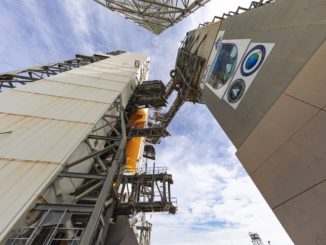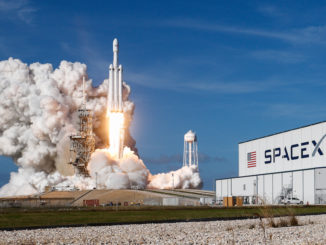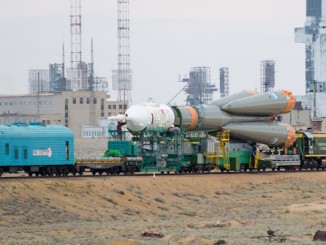
Northrop Grumman called off the launch of an Antares rocket and a Cygnus space station cargo freighter Thursday night on Virginia’s Eastern Shore, the third aborted countdown in less than 24 hours for three different U.S. rockets.
The countdown at Wallops Island, Virginia, was ticking down to liftoff of the 14-story Antares launcher at 9:43 p.m. EDT Thursday (0143 GMT Friday) to kick off a two-and-a-half day pursuit of the International Space Station with nearly 8,000 pounds of cargo, provisions, and experiments.
But a member of the launch team announced an abort around 2 minutes and 40 seconds before liftoff. The countdown had encountered a five-minute delay earlier Thursday evening that pushed the launch attempt to the end of the day’s available window.
That meant any stoppage in the countdown would automatically delay the launch to another day. The launch team began procedures to “safe” the Antares rocket and drain its liquid propellants. The Antares launch conductor instructed the team to tentatively set up for another launch attempt Friday at 9:16 p.m. EDT (0116 GMT Saturday).
Northrop Grumman, lead contractor on the Antares rocket and Cygnus supply ship, tweeted that managers scrubbed Thursday night’s launch attempt “after receiving off-nominal data from ground support equipment.”
Plans to proceed with another launch attempt Friday night in Virginia hinges on the Antares team resolving the problem that caused the abort Thursday night.
The Antares rocket’s abort Thursday night was the third time in less than 24 hours that a U.S. rocket launch was halted moments before takeoff.
A SpaceX Falcon 9 rocket launch from the Kennedy Space Center in Florida was supposed to launch at 9:17 a.m. EDT (1317 GMT) Thursday, but the countdown stopped at T-minus 18 seconds due to an unexpected reading from a ground sensor, SpaceX said.
The Falcon 9 rocket is set for another launch opportunity this weekend, perhaps as soon as Saturday. It is set to deploy 60 more satellites for SpaceX’s Starlink internet network.
Just hours before the Falcon 9 countdown, a United Launch Alliance Delta 4-Heavy rocket was poised to blast off from pad 37B at Cape Canaveral Air Force Station with a classified spy satellite for the National Reconnaissance Office. That launch was also aborted, and the countdown stopped seven seconds before the mission’s targeted liftoff at 11:54 p.m. EDT Wednesday (0354 GMT Thursday).
Tory Bruno, ULA’s president and CEO, tweeted that the Delta 4-Heavy countdown was halted by an automatic sequencer after a “sensor detected a fault” just before ignition of the rocket’s three main engines.
A new launch date for the Delta 4-Heavy rocket, which had suffered several delays since late August, has not been announced by ULA. It is expected to be grounded at least several days.
SpaceX is preparing another Falcon 9 rocket for launch during a 15-minute window opening at 9:43 p.m. EDT Friday (0143 GMT Saturday) with a Global Positioning System navigation satellite for the U.S. military. Preparations for that launch are moving forward on pad 40 at Cape Canaveral Air Force Station.
Assuming Antares launch from Virginia and the Falcon 9 launch from Florida both go ahead Friday, the rockets could fire into orbit just 27 minutes apart.
Their flight paths will even intersect, with the Antares launching first toward the southeast from Virginia over the Atlantic Ocean. The Falcon 9’s trajectory over the Atlantic toward the northeast from Cape Canaveral will cross the Antares rocket’s path, but by that time, the Antares will already be in orbit thousands of miles away.
The Antares rocket’s mission is to place Northrop Grumman’s automated Cygnus supply ship into orbit on the way to the space station. Northrop Grumman is performing the cargo delivery mission under contract with NASA.
The Cygnus cargo freighter for this mission — the 14th resupply flight to the space station by Northrop Grumman and its predecessor companies — is named the “S.S. Kalpana Chawla” in honor of the Indian-born American scientist and astronaut who died with her six crewmates on the space shuttle Columbia in 2003.
The items stowed inside the Cygnus supply ship include a new zero-gravity toilet for the space station, virtual reality camera gear to be used on a future spacewalk, scientific experiments, and fresh food, clothing and other provisions for the astronauts living on the orbiting research complex.
Assuming the Antares rocket can take off Friday night, the Cygnus cargo craft is scheduled to arrive at the space station early Monday. Astronauts will begin unpacking the supply ship once it arrives at the station, where it is expected to remain attached for around two months.
At the end of the mission, the spacecraft will depart the station to perform a flame combustion experiment inside its pressurized cabin. Then it will re-enter the atmosphere over the South Pacific Ocean and burn up, disposing of several tons of trash from the space station.
Email the author.
Follow Stephen Clark on Twitter: @StephenClark1.



